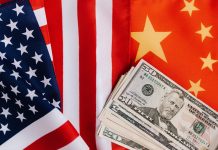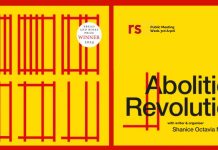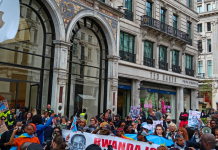The workers who built China’s emergency hospitals are missing from the dominant narratives about China and the Covid-19 pandemic, writes Hsiao-Hung Pai.

The 24-year-old young man, nicknamed ‘Messi’ because of his love of football, had been on the building sites in Wuhan, Hubei province, for two months. He had worked in construction from the age of thirteen, for over a decade now. After the Covid-19 outbreak was officially confirmed in China in late January, with the numbers infected on the rise, ‘Messi’ joined the massive construction project of Wuhan’s largest, 25,000-square-metre emergency hospital Huoshenshan (Fire God Mountain) on the outskirts of the city.
Thousands of migrant workers from the countryside, like ‘Messi’, put in long days of backbreaking work to build two emergency hospitals from 24 January when the work commenced. Many of them were trapped in Wuhan when the city was sealed off on 23 January and couldn’t return home for the Lunar New Year. Others were recruited and joined the construction project from nearby villages. At Huoshenshan, around 7,000 workers worked long shifts to get the hospital site ready by 4 February. As China Labour Bulletin (CLB) revealed, there was not even a shift system at the start of the works – many had to work for 10 hours straight with only a short lunch break. Later, the work was organised into two shifts, with workers on 12-hour shifts each day.
In addition to excessive working hours and underpayment, workers were also at greater risk of accidents and infection. On the eve of the hospital’s opening day, a dozen workers, equipped only with thin masks that offered little protection, could be seen fixing a leaking drainage pipe,
said CLB. One worker on the Huoshenshan construction has been confirmed as infected with Covid-19, as have his parents. None of them was able to find a place at any of the city’s overcrowded hospitals.
Through their tremendous efforts, these workers completed the project and the Chinese government received much praise from around the world for its capacity to build hospitals within a short time. It was nicknamed ‘Chinese speed’ as Huoshenshan Hospital was built in ten days and started taking in patients on 4 February. Yet some migrant workers were still demanding wages they were owed. As the work was organised via layers of construction contractors and agencies, the authorities shrugged off any responsibility for wage arrears. When a group of workers asked for their wages from 14 February, the authorities couldn’t confirm details of their pay, despite obvious anger among citizens on Weibo.
Meanwhile, on Chinese state media, several ‘model workers’ were praised for ‘not taking wages’ – their contact details weren’t even taken when they were hired, thus giving the authorities and employers the excuse to not pay them. Soon enough, these ‘model workers’ were renamed ‘volunteers’ who ‘sacrificed for the greater good’.
Chinese workers’ faces have not made an appearance on our TV screens here in Britain when daily news broadcasts update us on Wuhan’s return to normality. Their indispensable role and the price they paid for the country’s disease control effort, has never been acknowledged in the global coverage of the ‘Covid-19 story’.
Class struggle in China
The story has been all about what China did or didn’t do. While right-wingers ethnicised their critiques of ‘China’, many on the left romanticised ‘China’ in its defence. What both are doing is treating and essentialising ‘China’ as a unified block, devoid of class and class struggle. No matter how the concept is dressed up, this is part of the ‘clash of civilisations’ Orientalist perspective which racialises the Chinese state and society and sees ‘China’ as culturally unique, unified and fundamentally different from the rest of the world.
Back in the real world, class struggle continues. Following the lockdown during which workers’ protests and industrial action came to a halt, as did everything else, workers in China are now beginning to return to collective organising and action once again. As reported by CLB, since business outside Hubei province resumed production after the extended Lunar New Year break in mid to late February, there were 25 ‘mass incidents’ (as protests are officially called), mainly in service and transport industries that were already experiencing economic difficulties prior to the covid-19 outbreak. As usual, many protests were related to wage arrears and layoffs.
One of the protests was at a hospital in Zibo, Shandong province, on 9 March, where medical staff demanded payment of their owed three months’ wages and claimed that the hospital was using expired medical supplies. ‘Given that Covid-19 is still prevalent in many parts of the country, it is remarkable that there are any collective protests and demonstrations at all,’ said CLB.
Among the labour protestors are, once again, construction workers. Some of them protesting over unpaid wages, according to CLB. On Weibo, many concerned citizens discussed the situation of these workers.
One of them said on 28 March:
How do I put it? Amidst plenty of praise for our country as compared with the outside world [regarding disease control], I’ve been feeling unsure and restless…Until now, when people start talking about the construction workers of Wuhan’s emergency hospitals – among them some even unable to return home because of the fear of infection. And there are some hospital cleaners who have their wages withheld… When hearing this, I feel more ‘feet on the ground’, at last, there’s talk of human reality.
The ‘China dream’
This is part of human reality hidden behind the ‘China dream’ discourse of the ruling class. ‘China dream’ is not only a national catchphrase for the country’s aspirations for the future; it is the elite’s politico-economic programme for ‘the realisation of the great revival of the Chinese nation’. It is a natural outcome of China’s economic reform and opening up, known as gaige kaifang over the past four decades, characterised by economic liberalisation, waves of closure of state-run enterprises, massive privatisation, dismantling of public services, free reign for international capital and the anarchy of the market.
Under the ‘get rich first’ ethos in this period, China grew to have the world’s second-highest number of billionaires with total wealth of $996 billion. More than a third of the global conglomerates are based in China. The country’s top richest 100 individuals have more wealth than the poorest two-fifths of the population. As result of gaige kaifang, China became one of the world’s most unequal societies.
The income gap between classes is fundamentally tied in with the wealth gap between country and town, which widened unprecedentedly during gaige kaifang. The extremely uneven distribution of national wealth, coupled with corruption and the impact of economic liberalisation (eg. opening doors to imported agricultural products) led to further impoverishment of the rural interior and resulted in the largest mass migration in human history – millions of rural villagers went to seek means of livelihoods in the cities.
In 2012 following the 18th Party Congress, Xi Jinping began his reign by saying,
The China dream gathers Chinese aspirations and wishes for generations and manifests the interests of the whole Chinese nation… As history has shown us, each individual’s future and destiny is tied up with that of their nation.
He predicted that this ‘dream’ will be realized by the time China reaches the 100th anniversary of the founding of the People’s Republic.
Then, just as now, a team of ‘model workers’ were chosen and lined up in front of state media spotlight, showing allegiance to the ruling elite. Meanwhile, outside the grand spectacle of the Congress and Xi’s coming to power, workers carried on voicing their anger in their workplaces. Miao Cuihua, who spoke for migrant workers, posted a protest video online demanding the authorities listen. She demanded payment of overdue wages to construction workers in her workplace in Tianjin. As their case was one of tens of thousands across the country, this cyber protest attracted over one million viewers within two days.
But the ruling elite said this century is the ‘Chinese century’. Xi’s multibillion-dollar Belt and Road Initiative (BRI) launched in 2013, has been part of this grand project aimed towards the ‘China dream’. It is a massive global investment programme, encompassing Asia Africa and Europe in its sphere of influence. China began heavily investing in infrastructure projects globally, in more than 60 countries that account for 60% of the world’s population. From 2013 to 2018, the Chinese state made nearly $614 billion worth of investments in developing countries that were part of the BRI.
There is concern across Africa that China’s foreign investment campaign is a form of encroachment as those countries involved are at risk of losing control of their essential infrastructure and natural resources, with their debt burden increased. The Chinese state offered $60 billion in grants and loans to finance development projects in Africa in 2015. As a result, China now holds 14% of the total debt stock in Sub-Saharan Africa and has become the largest owner of public debt in Africa. In the eyes of many Africans, BRI is indeed a new form of colonialism.
Domestically, the elite’s nationalist ambitions for greater global wealth and power aren’t shared by all. The anger and frustration among the working-class is best illustrated by high level of ‘mass incidents’ across the country. Millions of migrant workers – who are Chinese citizens – continue to be subjected to permanent injustices in the cities as BRI makes its way in the world. They are treated as second-class citizens in their own country and are denied basic public services in the cities as result of the hukou system. You look around and see children of different class origins entitled to differential education opportunities. You see workers toiling away in urban sweatshops risking their health and safety without even the guarantee of payment in the end. You see them being depended upon for their labour but socially segregated in the cities of violence. You hear of a miner having his chest opened up to prove his occupational lung disease to expose cover-ups by his employer and receive basic compensation; you hear people talking about their fellow villagers who went to work in the mines and lost their lives like thousands already did each year. You feel powerless because you can do nothing about it, given the omnipresent power of the state.
Then you realize that the ‘China dream’ of wealth and national pride actually excludes the vast majority of its citizens. What do ‘the interests of the whole Chinese nation’ mean to a large section of China’s working-class whose aspirations and hopes for the future have not been represented?
Some workers are taking matters into their own hands. The 2010s was a decade marked by waves of spontaneous industrial action across Chinese towns and cities. Those at the forefront of these struggles were migrant workers, young men and women, from the interior, who often defied state-run trade union organisations and pushed for independent workers’ unions.
In 2018, when the Chinese government marked the 40th anniversary of its gaige kaifang and the beginning of Xi’s second five-year term as the country’s leader, Xi went beyond ‘national rejuvenation’ to call for the country to be in the front rank of global powers measured by economic development and military power by 2049.
Western apologists
This ascent of the ‘China dream’ has been celebrated and promoted by Orientalists who simply choose to be blind to what has happened within China all these years. The Chinese ruling class is not short of these leech-like Western apologists as there is plenty of cash to be made clinging onto the state-entrepreneurial elite and grabbing as much as they can. Martin Jacques, the ideologue of the ‘civilisation state’ (as opposed to the nation-state), is one such type who has become the darling of the Chinese state. He asks ‘the West’ to talk of China ‘on its own terms, with its own rules’. ‘China is profoundly different from the West in the most basic of ways,’ he said.
The most basic difference is that it is not a nation-state in the European sense of the term. Indeed, it has only described itself as such since around 1900… China, as we know it today, dates back to 221BC, in some respects much earlier. That date marked the end of the Warring States period, the victory of the Qin, and the birth of the Qin Empire… For over two millennia, the Chinese thought of themselves as a civilization rather than a nation.
Jacques imagines that China evolved from an entirely different system with incompatible values and traditions from the West and should be looked at in isolation:
The reason why the Chinese state enjoys a formidable legitimacy in the eyes of the Chinese…can be found in the relationship between the state and Chinese civilization. The state is seen as the embodiment, guardian and defender of Chinese civilization.
Such Orientalism sees Chinese people as natural subjects ‘in harmony’ with the state. This thinly-veiled racialisation has serious consequences. One of the worst conclusions resulting from it is that ‘it is not in the nature of Chinese culture and values to wish for egalitarianism’. Thus, Jacques consistently endorses gaige kaifang and finds justification for the political repression of the Chinese state. He is able to do so and has gained a following among Stalinists and liberals alike, because his ideas are often dressed up as advocating the ‘tolerance’ of ‘cultural differences’.
Not surprisingly, Jacques is much cited and praised by the Chinese state media. Early in the Covid-19 pandemic, he was interviewed by the government mouthpiece Global Times, when he hailed the success of the ‘Chinese way’ in dealing with the outbreak. In this Orientalist narrative, the working class, or even the concept of class, has not only become submerged but has disappeared altogether. The reality is, however, the great divide is not between China and the rest of the world, but between the haves and have-nots globally – and China is no exception.
Hsiao-Hung Pai is the author of Chinese Whispers: The Story Behind Britain’s Hidden Army of Labour (London: Penguin, 2008), Scattered Sand: The Story of China’s Rural Migrants (London: Verso, 2013) and Bordered Lives: How Europe Fails Refugees and Migrants (Oxford: New Internationalist, 2018).




















[…] brunt of the front work in China’s total mobilization was undertaken by low-paid migrant workers. This included the celebrated construction of new hospitals undertaken by underpaid rural migrants […]
[…] brunt of the front work in China’s total mobilization was undertaken by low-paid migrant workers. This included the celebrated construction of new hospitals undertaken by underpaid rural migrants […]
[…] brunt of the front work in China’s total mobilization was undertaken by low-paid migrant workers. This included the celebrated construction of new hospitals undertaken by underpaid rural migrants […]
[…] brunt of the front work in China’s total mobilization was undertaken by low-paid migrant workers. This included the celebrated construction of new hospitals undertaken by underpaid rural migrants […]
This is an important, interesting and welcome article. During the last few months, coverage of China has seemed to focus on either the wet markets as the cause of COVID-19 or the strategy to defeat the virus. As the writer points out, the right-wingers have been using explicit racism to describe Chinese people. The Maoists or trendy liberals have pointed to Chinese “culture”. Both of those groups refer to Chinese people as one homogenous mass.
This article focuses on the workers, who have been ignored in any other discussion and as such is vitally important, especially at this time when workers everywhere are paying the price for capitalism and its neglect of health and safety questions.